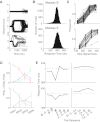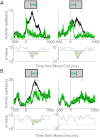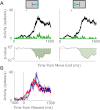Performance monitoring by presupplementary and supplementary motor area during an arm movement countermanding task
- PMID: 23324325
- PMCID: PMC3628008
- DOI: 10.1152/jn.00688.2012
Performance monitoring by presupplementary and supplementary motor area during an arm movement countermanding task
Abstract
A key component of executive control and decision making is the ability to use the consequences of chosen actions to update and inform the process of future action selection. Evaluative signals, which monitor the outcomes of actions, are critical for this ability. Signals related to the evaluation of actions have been identified in eye movement-related areas of the medial frontal cortex. Here we examined whether such evaluative signals are also present in areas of the medial frontal cortex related to arm movements. To answer this question, we recorded from cells in the supplementary motor area (SMA) and pre-SMA, while monkeys performed an arm movement version of the countermanding paradigm. SMA and pre-SMA have been implicated in the higher-order control of movement selection and execution, although their precise role within the skeletomotor control circuit is unclear. We found evaluative signals that encode information about the expected outcome of the reward, the actual outcome, and the mismatch between actual and intended outcome. These findings suggest that signals that monitor and evaluate movement outcomes are represented throughout the medial frontal cortex, playing a general role across effector systems. These evaluation signals supervise the relationship between intentional motor behavior and reward expectation and could be used to adaptively shape future goal-directed behavior.
Figures










Similar articles
-
Medial frontal cortex motivates but does not control movement initiation in the countermanding task.J Neurosci. 2010 Feb 3;30(5):1968-82. doi: 10.1523/JNEUROSCI.4509-09.2010. J Neurosci. 2010. PMID: 20130204 Free PMC article.
-
Changing directions of forthcoming arm movements: neuronal activity in the presupplementary and supplementary motor area of monkey cerebral cortex.J Neurophysiol. 1996 Oct;76(4):2327-42. doi: 10.1152/jn.1996.76.4.2327. J Neurophysiol. 1996. PMID: 8899607
-
Distribution of eye- and arm-movement-related neuronal activity in the SEF and in the SMA and Pre-SMA of monkeys.J Neurophysiol. 2002 Apr;87(4):2158-66. doi: 10.1152/jn.00867.2001. J Neurophysiol. 2002. PMID: 11929933
-
Comparison of neuronal activity in the supplementary motor area and primary motor cortex.Brain Res Cogn Brain Res. 1996 Mar;3(2):143-50. doi: 10.1016/0926-6410(95)00039-9. Brain Res Cogn Brain Res. 1996. PMID: 8713555 Review.
-
Supplementary motor cortex in organization of movement.Eur Neurol. 1996;36 Suppl 1:13-9. doi: 10.1159/000118878. Eur Neurol. 1996. PMID: 8791016 Review.
Cited by
-
Neurophysiological mechanisms of error monitoring in human and non-human primates.Nat Rev Neurosci. 2023 Mar;24(3):153-172. doi: 10.1038/s41583-022-00670-w. Epub 2023 Jan 27. Nat Rev Neurosci. 2023. PMID: 36707544 Free PMC article. Review.
-
Neural mechanisms for executive control of speed-accuracy trade-off.Cell Rep. 2023 Nov 28;42(11):113422. doi: 10.1016/j.celrep.2023.113422. Epub 2023 Nov 10. Cell Rep. 2023. PMID: 37950871 Free PMC article.
-
Single-Neuron Correlates of Error Monitoring and Post-Error Adjustments in Human Medial Frontal Cortex.Neuron. 2019 Jan 2;101(1):165-177.e5. doi: 10.1016/j.neuron.2018.11.016. Epub 2018 Dec 4. Neuron. 2019. PMID: 30528064 Free PMC article.
-
Different population dynamics in the supplementary motor area and motor cortex during reaching.Nat Commun. 2018 Jul 16;9(1):2754. doi: 10.1038/s41467-018-05146-z. Nat Commun. 2018. PMID: 30013188 Free PMC article.
-
Agranular frontal cortical microcircuit underlying cognitive control in macaques.Front Neural Circuits. 2024 Mar 27;18:1389110. doi: 10.3389/fncir.2024.1389110. eCollection 2024. Front Neural Circuits. 2024. PMID: 38601266 Free PMC article. Review.
References
-
- Akkal D, Bioulac B, Audin J, Burbaud P. Comparison of neuronal activity in the rostral supplementary and cingulate motor areas during a task with cognitive and motor demands. Eur J Neurosci 15: 887–904, 2002 - PubMed
Publication types
MeSH terms
Grants and funding
LinkOut - more resources
Full Text Sources
Other Literature Sources

